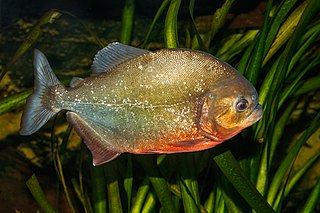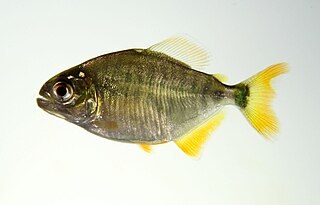
Pygocentrus is a genus of the piranha family Serrasalmidae. All species are native to tropical and subtropical South America. All the species are predatory, scavengers and may form large schools. The famous red-bellied piranha, Pygocentrus nattereri, is one of four species in the genus.

Leporinus is a genus of fish in the family Anostomidae native to South America. The fossil species Leporinus scalabrinii, known from the late Miocene of Entre Ríos in Argentina, has only recently been added to this genus after being misidentified as a species of primate under the name Arrhinolemur scalabrinii for over 100 years.

The red-bellied piranha, also known as the red piranha, is a species of piranha native to South America, found in the Amazon, Paraguay, Paraná and Essequibo basins, as well as coastal rivers of northeastern Brazil. This fish is locally abundant in its freshwater habitat. They are omnivorous foragers and feed on insects, worms, crustaceans, and fish. They are not a migratory species but do travel to seek out conditions conducive to breeding and spawning during periods of increased rainfall. Red-bellied piranhas often travel in shoals as a predatory defense but rarely exhibit group hunting behavior. Acoustic communication is common and is sometimes exhibited along with aggressive behaviors. They are a popular aquarium fish.

Pristobrycon is a genus of piranhas from the Orinoco and Amazon Basins, as well as rivers in the Guianas.

Pimelodella is a genus of three-barbeled catfishes.

Bryconops is a genus of freshwater fish in the family Iguanodectidae from South America. Various species of tetra are amongst its ranks, and are sometimes seen in the aquarium trade.
Pristobrycon careospinus is a species of serrasalmid endemic of Venezuela.
Pristobrycon maculipinnis, sometimes known as the marbled piranha, is a species of serrasalmid endemic to Venezuela.
Pristobrycon striolatus is a species of serrasalmid fish.

Moenkhausia is a genus of freshwater fish in the family Characidae native to tropical and subtropical South America. These are medium-sized tetras where the largest species only reach around 12 cm (4.7 in).

Pygopristis denticulata, or the Lobetoothed Piranha is a species of piranha. These fish are part of the group Ostariophysi, a large group of freshwater fish that includes minnows and catfishes. It is a rare South American fish found in the Orinoco River basin, north and eastern Guiana Shield rivers, and tributaries of the lower Amazon River. Piranhas typically live in freshwater, but other specimens can be found elsewhere. Specimens of this species is frequently found in acidic clear or black waters. Piranhas are primarily known for being savage, flesh-eating fish, but they actually have broader diets. They usually feed on aquatic insects, small fish, and fruits.

Myleus is a genus of serrasalmids from South America, where found in the Amazon, Orinoco and São Francisco basins, as well as river basin of the Guiana Shield. They are found in rivers with moderately or fast-flowing water, including rapids. They are primarily herbivores, but also take some animal matter. Depending on the exact species, they reach up to 12–42 cm (0.4–1.4 ft) in standard length, and the adult males have a double-lobed anal fin and filamentous extensions on the dorsal fin. Their strong teeth means that larger individuals can inflict severe bites on humans.

Myloplus is a genus of freshwater fish in the family Serrasalmidae found in tropical and subtropical South America, where they inhabit rivers and streams. They are primarily herbivores, but also take some animal matter. Depending on the exact species, they reach up to 16–56 cm (0.5–1.8 ft) in standard length. Adult males have a double-lobed anal fin and filamentous extensions on the dorsal fin, and both sexes can be brightly colored when breeding.
Tometes is a genus of fish in the family Serrasalmidae found in fast-flowing rivers in northern South America. Adults of all seven species in this genus are phytophagous, feeding primarily on aquatic plants in the family Podostemaceae.
Kritskyia is a genus of monogeneans in the family Dactylogyridae.

The Ministry of Economy and Finance is a ministry of the government of Venezuela with similar portfolios dating back to 1810 with the creation of a tax office. When Gran Colombia was dissolved and Venezuela assumed its independence, the Ministry of Finance was created in 1830 when General José Antonio Páez commissioned the establishment of the public business office to three Secretariats of State: Interior, Justice and Police, War and Navy, Finance, and Foreign Relations. The current minister has been Delcy Rodríguez since September 2020.

Iguanodectidae is a family of freshwater fish in the order Characiformes that lives in South America. It is home to the subfamily Iguanodectinae and the monotypic Bryconops clade. Several species in the family, such as the green line lizard tetra, the tailspot tetra, and the orangefin tetra, are sometimes taken as aquarium fish.
The orangefin tetra is a small species of freshwater fish from South America that belongs to the family Iguanodectidae. Though common in its native range, it seems to prefer fast-flowing and shallow creeks. It is an active swimmer that feeds on plant material and various invertebrates, sometimes jumping out of the water to catch prey above the surface.

Bryconops giacopinii is a mid-sized species of freshwater fish in the family Iguanodectidae. It is the largest member of the genus Bryconops, and is therefore difficult to confuse with any of its congeners. With a diet that consists largely of land-dwelling insects, it serves as an important link between the terrestrial and aquatic aspects of its native range.












